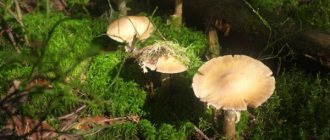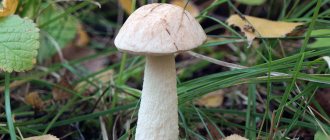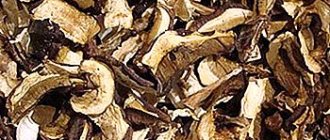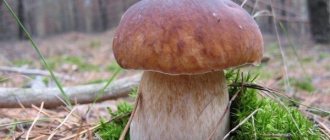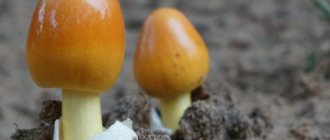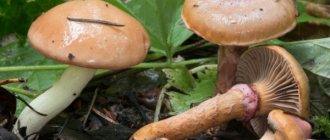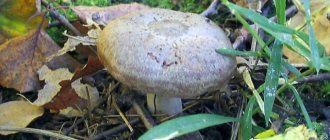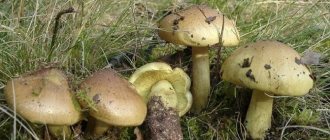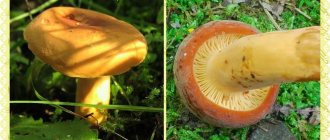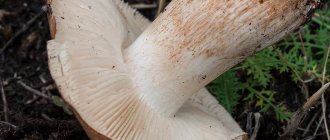» Mushrooms » Edible mushrooms » Liver mushroom: description and healing properties
0
1986
Article rating
The liver fungus, or common liverwort, is a tinder fungus from the Fistulinaceae family. Grows on trees. In appearance it resembles a liver. It has properties beneficial to human health.
- Medicinal properties
- Places of growth and time of collection
- Processing rules and cooking technology
- Frying
- Drying
Liver mushroom: description and healing properties
Description of the mushroom
This species received its unusual name for its resemblance to the liver of animals; it is called the common liverwort, the common liverwort, and the hepatic polypore. People humorously call it Teschin or wolf tongue. In Europe and among the Western Slavs, the species is called Bovine tongue. The English folk name - The poor man's beefsteak - is quite eloquent.
Latin name: Fistulina hepatica. Phylum: Basidiomycota, Order: Agaricales, Family: Fistulinaceae.
The liver mushroom has recently been included in the Red Book of Belarus and is protected by law in Poland. The cost of 1 kg of mushroom in Europe varies from 6 to 50 euros.
The cap has a tongue-like, elongated shape, tapering towards the stem. Its size varies between 25–30 cm, thickness is about 6 cm. The surface is sticky and lumpy. In young specimens it is orange in color, slightly rough, and with age it becomes purple-burgundy and gelatinous.
The hymenophore (lower part of the cap) is finely porous, first yellowish, then brown. Upon examination, it seems that this layer consists of small tubes. When pressed, it darkens, often the surface begins to become covered with pink drops, which determines the name of the species.
Interesting! When cut, the mushroom also looks like a piece of pork liver - with the same marble veins and moiré stains. The older, fattier and juicier the fruiting body is, the more its resemblance to beef meat or liver becomes stronger when cut.
The pulp is characterized by a dense, elastic structure, it is fleshy and juicy. In adult specimens it hardens and becomes fibrous. The smell is slightly fruity, the taste is sour-bitter.
The leg is lateral, short, and often not visible at all.
A little history
The first mention of this mushroom dates back to 1769; the species was identified as Boletus buglossum Rezius.
Places of growth and general characteristics
Warm climates are favorable for the growth of liver fungus. It is extremely rare in the northern regions. It grows not only at the base of old trees, but also on stumps and in hollows. Most of all it likes to live on oaks and chestnuts, and in Australia it can be found on eucalyptus. Some mushroom pickers found it on birch trees. Its shape resembles a cow's tongue, as it is often called. In addition, it has several other names:
- bugloss;
- mother-in-law's tongue;
- common liverwort;
- liverwort mushroom;
The wet, sticky and rough cap is elongated, spherical or fan-shaped and has a dark red and brown-burgundy color. The young mushroom is usually red-orange in color. The lateral stalk of the liverwort is thick and short; it can grow from below and above the cap, but most often it is poorly defined. For this reason, the mushroom body can be attached to the trunk by the edge of the cap. A mature mushroom is very similar to a tinder fungus. Grows up to 15−20 cm . Weight reaches 1.5-2 kg, and sometimes heavier specimens are found.
The benefits and harms of oyster mushrooms for the body
The dense flesh of the liverwort is very juicy, streaked, as if filled with blood. When cut, red juice is released. When you press on the flesh on the underside of the liverwort, blood prints are formed. The older the liverwort gets, the more it becomes like a meat product.
In damp weather, red drops can be seen on the surface of young mushrooms, which are released from excess moisture. The juiciness of the pulp is directly dependent on the humidity of the places where this mushroom lives and on the trees on which it grows. In particularly juicy specimens, the surface becomes sticky, reminiscent of thick jelly. On rainy days, such mushrooms can even spread.
Liverwort that has dried directly on a tree can be safely eaten. But if it has hardened and become like charcoal, it is better not to touch it.
False doubles
Has no doubles. There is no mushroom in the forest that looks like a “tree liver”. Pay attention to the photos, which very eloquently prove this statement. But some lovers of quiet hunting may well confuse this species with others, although this is quite difficult.
Dangerous twins
| Type name and differences | Bristle-haired tinder fungus | Tinder fungus |
| What does the fruiting body look like? | Cap, often formed by several caps; Juveniles have a red-orange hue, which turns to almost black or dark brown with age. | fan-shaped body with cork structure |
| Pulp | Has a brown color | Gives off a woody aroma |
| Where can I meet | affects deciduous trees (apple, alder, oak, ash, elm, poplar, etc.). | They grow in groups, although single specimens are also found. |
Liverwort or hepatica (Hepatica) common and noble
Liverwort, coppice or hepatica (Hepatica) is a genus of perennial herbs of the buttercup family, growing in the forests of the temperate zone of the Northern Hemisphere. Used in decorative floriculture.
- Family: Ranunculaceae.
- Homeland: Northern Hemisphere.
- Rhizome: short, tuberous.
- Stem: straight.
- Leaves: petiolate, three-lobed.
- Fruit: nut.
- Reproductive ability: propagated by dividing rhizomes and seeds.
- Illumination: shade-tolerant.
- Watering: moderate.
- Keeping temperature: frost-resistant.
- Flowering duration: 3-4 weeks in April-May.
Description of the liverwort flower
An early flowering perennial plant 15-20 cm high with a rosette of three-lobed, petiolate, pubescent leaves at the bottom, red-violet at the beginning of the growing season, then dark green, dense, leathery, overwintering in some species. The flower of the liverwort, or hepatica, is blue, less often white or pink, solitary, 2-4 cm in size, located on a straight, pubescent, bare peduncle, looking like a cup with 6-10 petals. All parts of the plant are poisonous.
Common ornamental types of liverwort
The genus is not numerous; according to different classifications, it includes from 2 to 10 species. In Russia, only the noble liverwort, or common liverwort (H. Nobilis), grows in nature.
This species with trifoliate dense leaves on long petioles and single lilac flowers up to 4 cm in diameter feels good both in shady places and in lighted areas on loose, moderately moist soil.
In cultivation there are terry varieties of white, purple, pink, and violet colors. There are subspecies:
The Asian liverwort (H. asiatica), sometimes identified as a separate species, grows in the Far East, China, Korea, Japan, has white, pink, purple flowers, unlike the noble liverwort, it sheds its leaves in the winter;
Japanese liverwort (H. japonica) and pubescent liverwort (H. pubescens), the latter is distinguished by rounded leaves with a marbled pattern.
Acute liverworts (H. acutiloba) and obtuse liverworts (H. acutiloba, H. americana), native to America.
One European species,
the Transylvanian liverwort (H. transsilvanica), native to the Carpathians, is distinguished by large blue or purple flowers and deeply cut trifoliate leaves.
A separate species called the average liverwort (H. media) is a group of hybrids of the Transylvanian liverwort with other species. These are plants with double flowers of blue, white, pink colors, blooming in April for a longer period than other garden forms.
To date, about 1000 varieties are known. Due to difficulties with reproduction, prices for new items reach $3,000. Flowers are especially popular in Japan, where exhibitions of flowering liverworts are held annually; varieties have been created not only with double flowers of various colors, including two-color and three-color, but also with variegated foliage.
Photos of liverworts of various types and varieties are given below.
Cultivation and propagation of liverwort
Liverwort is a long-lived plant; its lifespan can reach 25 years.
Natural forms require specific conditions, more moist and fertile soil with the addition of peat and spruce needles, replanting and dividing every 3-4 years.
Garden varieties are less demanding, develop well in the shade and in the open sun, in dry and moderately moist areas, and can grow without division in one place for quite a long time.
https://www.youtube.com/watch?v=oX4yP7fgdIE
All liverworts prefer light, well-fertilized soils with a neutral or slightly acidic reaction, and a semi-shaded location. They can grow in significant shade and on alpine hills, near large stones, but in the sun the flowering time is reduced.
Liverwort flower in the photo.
The plant is poorly competitive; in order to obtain spectacular flowering clumps, it must be protected from its intensively growing neighbors.
Otherwise, care is not complicated; it consists of keeping the soil moderately moist and free from weeds.
To fertilize, you can add bone or blood meal at the end of winter, and mineral fertilizer with potassium and phosphorus at the end of summer. For the winter, mulching with neutral peat or leaf humus is recommended.
Propagated by dividing rhizomes or seeds. Propagation by seeds is difficult; they often fall immature in early June, and in double forms they do not set at all. Sowing is carried out in June without seedlings in the ground with freshly harvested seeds. Shoots will appear in a year, seedlings will bloom in 3-4 years.
Varieties, hybrids, sterile, including terry forms are divided into parts in July-August, leaving at least 2-3 buds on each. Plant at a distance of 20 cm, water and shade. By autumn, the cuttings have taken root and usually bloom the following year.
Source: https://www.flowerbank.ru/?p=1479
Evaluation of taste qualities, medicinal properties, benefits and possible harm
When young, before the flesh becomes woody, Fistulina hepatica is considered a good edible mushroom with a delicate flavor and a strong sour taste. It can be cooked in a frying pan, added to salads with herbs and olive oil, pickled, frozen, boiled, pickled, fried, or made into cutlets.
Interesting! The liverwort is rich in vitamin C: 100 g of its pulp contains the daily intake for an adult.
Experts who study the medicinal qualities of mushrooms claim that liverworts are very useful in the treatment of cancer. They restore disrupted metabolic processes, help cleanse the body and are excellent antioxidants.
Note! Any treatment must be prescribed and accompanied by a doctor. Self-medication is unacceptable and will lead to negative consequences!
Mother-in-law's tongue is rich in ascorbic acid, it contains:
- vitamins D and PP;
- minerals;
- proteins;
- phosphorus;
- carbohydrates;
- water.
It is not recommended to use these mushrooms for diseases of the gastrointestinal tract, kidneys, liver and gout. It is not advisable to give dishes from it to children.
Contraindications
It has no special contraindications. Adults and children can eat it, although some sources say it is still not recommended for children. Young women who are breastfeeding or pregnant should avoid taking it, but other sources say it is safe for pregnant women to use. Combines a number of beneficial properties and healing qualities. Belongs to the edible fourth category.
Homemade recipes
Young fruiting bodies are eaten until the flesh becomes coarse. Mother-in-law's tongue mushroom belongs to category 4 and is used in preparing many dishes. Liverwort can be pickled, fried, cooked over a fire and barbecue, made into caviar, etc.
Primary processing
How to cook mother-in-law's tongue mushroom correctly? Very simple. Immediately after collection, the fruiting bodies should be soaked in cold salted water for 3–4 hours. Then clean the mucus from the caps and rinse the mushrooms thoroughly.
Cooking
After preliminary soaking, the liverwort must be thoroughly rinsed again, removing all veins and juice. Then the fruiting bodies are placed in a colander, the liquid is allowed to drain and used further for their intended purpose.
Cold and hot marinating
To make pickled fistulins, you will need the following ingredients (based on a 1-liter jar):
- mushrooms – 2 kg;
- salt – 1 tbsp. l.;
- sugar – 1 tbsp. l.;
- allspice – 8 pcs.;
- vinegar - 2 tbsp. l.;
- bay leaf – 3 pcs.;
- garlic, horseradish root - to taste;
- vegetable oil – 2 tbsp. l.;
- mustard beans - 2 pinches.
Cooking process step by step:
- Liverworts need to be boiled in 3 batches of 20 minutes each. The fruiting bodies should be thoroughly washed each time.
- Spices, salt, sugar, vinegar are placed in each jar.
- Fill the jars to the top with mushrooms.
- Pour boiling water over. Pour vegetable oil into each container.
- Roll up the jars and cool. Preservation should be stored in a cool place.
The cold pickling method consists of other stages. You will need:
- water – 0.5 l;
- vinegar – 100 ml;
- salt – 30 g;
- bay leaf – 2 pcs.;
- black and allspice – 5 peas each;
- onions – 5 pcs.;
- fistulins - to taste, about 2 kg.
Cooking process:
- Mushrooms need to be boiled in the traditional way, in salted water. Cool.
- Layer liverworts and sliced onions into sterilized jars.
- Prepare a marinade from water, vinegar, spices, and salt.
- Fill the contents of the containers with boiling brine.
- A very important step is pasteurization: each jar must be placed in boiling water and cooked for another 30–40 minutes over low heat. Roll it up ONLY after that.
Freezing
The process of freezing this type of mushroom is no different from the others. The only condition: the fruiting bodies must first be boiled in salted water and washed. Cut the mushrooms into pieces and place in portions in containers. Store in the freezer.
Important! Arrange the blanks so that each can be used only once, no more. You should not refreeze and thaw mushrooms; they lose all their beneficial properties.
Fried liverwort with potatoes
Tender, soft, sour liverwort pulp harmonizes perfectly with crumbly potatoes. Before cooking mushrooms, mother-in-law's tongue must be thoroughly rinsed. In addition, you should know that only young specimens are suitable for food; it is better not to use old ones.
Ingredients:
- mother-in-law’s tongue – 1 kg;
- onions – 2 pcs.;
- potatoes – 500 g;
- salt, pepper - to taste;
- vegetable oil – 2 tbsp. l.;
- sour cream – 2 tbsp. l.
Cooking method:
- Cut the pre-processed, boiled liverworts into thin slices.
- Peel the vegetables: onions and potatoes. Cut them into cubes.
- Place the mushrooms in a hot frying pan and wait for the excess liquid to drain from them.
- Only then add oil and fry the fruiting bodies until golden brown with the addition of onions and potatoes.
- Salt the finished dish and season to taste. At the end, add sour cream, herbs and simmer for another 1 minute.
Pickling
To pickle liverworts for the winter, use a hot cooking method. It does not require pre-boiling the mushrooms, but they need to be washed very well and cut into thin strips.
Ingredients:
- salt – 20 g;
- mushrooms – 2 kg;
- allspice – 3 peas;
- black pepper – 8 pcs.;
- bay leaf -2 pcs.;
- cloves – 203 buds;
- dill - dry umbrellas;
- garlic – 2-3 cloves.
Cooking method:
- Pour some water into the bottom of the pan, put salt, and put fistulins on top.
- Cook for 20-25 minutes, cool.
- Place spices, peppers, and bay leaves in clean jars.
- Place mushroom pieces on top of the seasonings and season with garlic. Repeat layers.
- Place dill on top, pour 1 tbsp. l. vegetable oil.
- Seal the jars with nylon lids. Send the workpiece to a cold place. After 40 days, you can try the mushrooms.
Drying
This process cannot be called fast; it will take some time to prepare and dry the fistulins:
- Before drying, the liverwort does not need to be washed, just clean the fruiting bodies of debris and leaves.
- Cut the mushrooms into thin strips of 1-1.5 cm.
- To drain the red juice, you need to dry the fistulins a little - put them on a tray and keep them in a well-ventilated place.
- Dry the mushrooms in the oven for 4 hours at minimum temperature or cook in natural conditions (dark, shady place).
In winter, it will be enough to just soak the mushroom pieces in salted water and cook the liver mushroom the way you want.
Canning for the winter in jars
Another way to prepare mother-in-law’s tongue mushrooms is aromatic, spicy caviar for the winter. This dish is perfect for a winter table as a snack; in addition, it can be spread on toast and enjoyed with forest gifts at any time of the year.
Ingredients:
- mother-in-law's tongue – 500 g;
- onions, carrots - 1 pc.;
- vegetable oil – 30 ml;
- vinegar – 30 ml;
- salt, pepper - to taste.
Cooking method:
- Peel the vegetables. Fry carrots and onions in vegetable oil until soft.
- Pre-boil the mushrooms and rinse thoroughly. Cut into arbitrary pieces.
- Place the fruiting bodies in the pan with the vegetables. Fry until they acquire a beautiful golden hue and golden brown crust.
- Season the dish.
- Transfer the mixture to a blender and bring to the desired consistency.
- Place back in the pan and fry a little to remove the moisture.
- Place the caviar in clean, sterilized jars, pour in 1 tbsp. l. vinegar. Roll up.
- Store in a cool place.
Fried ox tongue
To prepare this dish, you need to take two kilograms of mushrooms, onions, sunflower oil and salt. The recipe is quite simple and accessible:
- Place the washed mushrooms in a saucepan and cover with salted cold water. Place on the fire, bring to a boil and then cook for another 20 minutes.
- Then drain the mushrooms in a colander and rinse. After the water has drained, cut the ox tongue into large pieces.
- Cut the onion into half rings.
- Heat vegetable oil in a frying pan and add mushrooms. Fry, stirring, for 20 minutes.
- When the moisture has evaporated, add the onion and cook until done. Add salt and pepper to taste. If desired, you can add sour cream or mayonnaise. Serve with mashed potatoes.
If you follow all the rules for preparing liver mushrooms, you can make many interesting and tasty dishes that, with their unusualness, will add a unique touch to the meal and make you want to try them more than once.
Interesting Facts
The meat mushroom, or as it is also called - bull's (wolf's, mother-in-law's) tongue, liverwort - is truly unique. It resembles a fresh piece of liver or meat glued to an oak tree or oak stump. You won't find anything like this in the forest anymore. When cut open, the mushroom begins to ooze like a real piece of liver, which gives this species its name.
Liverwort is a parasite and wood destroyer. It settles on old, still living oaks and chestnuts, on their stumps.
If you come across this strange gift of nature in the forest, do not pass by, cut the mushrooms. You won’t even notice how 5-6 fruiting bodies of the common liverwort have taken up almost all the space in your basket. Try cooking it with mother-in-law’s tongue; you will remember its sourish, soft taste for a long time!
Environmental characteristics
In general terms, ox tongue is similar to a mushroom from the tinder fungus family, although for them it is only a distant relative. At its core, it is a parasite and destroyer of the trees on which it grows.
It usually settles in places of damage, in cracks of old trees and even on near-surface roots. One tree can be inhabited by a whole family of liverworts of different ages. They mainly grow in the lower part of the trunk, but can rise to a height of 1-1.5 meters. Often they themselves cause the formation of hollows. They gain weight in the second half of summer and on rainy autumn days. In the southern regions they bear fruit until November.
Boletus mushroom: where it grows, edibility
Growing methods
The mycelium of the liverwort fungus is sold on oak sticks, which, after purchase, are embedded in a log or stump. To do this, holes of the appropriate diameter are drilled in them. If the block is too long, the remaining part is cut off and inserted into another recess. Mushroom sticks are also introduced into natural openings. Wood used for infection is sawn or live (dying plants).
Irina Selyutina (Biologist):
Indeed, when populating the mycelium of the liver fungus, it is recommended to use not only drilled, but also holes of natural origin - the main thing is that they are suitable in size. These may be the results of the “activity” of a woodpecker, or they may arise during the development of mistletoe and strapweed.
It is also important that the wood is from deciduous trees and not rotten, without traces of mold. It can be stored for several years, the main thing is that it meets all the characteristics necessary for growing this species.
Dry material should be moistened before inserting sticks:
- chocks - soaked for 2-3 days in water;
- stumps - doused 3-5 times a day for a week.
The oak block is also kept in water for 1.5-2 hours.
The area where the deck is placed must be in a shaded and humid place. A basement, cellar, garage, barn are also suitable for growing. Fruiting begins at a temperature of at least 8˚C after 3-7 months (sometimes the development period lasts up to a year). The later the liverwort appears, the longer the mycelium will bear fruit. For the winter, the foundations for growing are left outside or brought indoors. From one stick you get up to 1 kg of harvest.
MUSHROOMS Common Liverwort OR Mother-in-law's TongueEdible tinder fungus Common Liverwort / Fistulina hepatica LIVER MUSHROOM! Have you seen this?/ Common liverwort Fistulina hepatica

